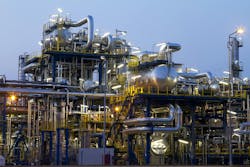Level measurement technology brings safety, sustainability and productivity to the chemical industry
There’s no doubt that level measurement technology has opened a world of opportunities for the industrial sector, particularly when it comes to the many diverse applications in the chemical industry. Not only have level technologies made it easier to obtain accurate level measurements, but they’ve also helped chemical industry operators ensure a higher level of safety while achieving their sustainability and productivity goals.
Of course, not all level technologies are the same, so Control asked Jenny Leion, chemical industry level manager at Emerson to explain those different options for operators and why each may work best for their applications.
Get your subscription to Control's tri-weekly newsletter.
Q: How can guided wave radar level technology improve safety and reduce environmental risks in chemical processes?
A: Guided wave radar is a key technology to measure both level and interface. This is very important, for example, for the petrochemical industry when it’s essential to avoid oil leaking into water or water leaking into the oil. This is not only key to avoid any leakages, but a proper level interface reading also helps petrochemical plants optimize their production by being able to utilize more of the process vessels volume.
Guided wave radar is also the preferred level solution for chemicals that have a very low dielectric or when the atmosphere in the process vessel makes it difficult for other technologies. Both for liquids applications such as ammonia and for solids applications, like for very dusty polymer applications.
Saturated steam applications, like boiler drums, are another example of when the right type of guided wave radar is useful for accurate level control.
Of course, even though guided wave radars come in a variety of different materials to withstand different chemicals, many times a non-contacting solution is preferred.
Q: How does non-contacting radar level measurement help maintain accuracy and reliability in highly corrosive chemical environments?
A: For many chemicals a non-contacting level measurement solution is preferred so the level transmitter doesn’t come in direct, constant contact with the media. This is true both for highly corrosive chemicals and for chemicals or processes where the media can be viscous or have impurities that can stick to the probe or seal and make the instrument reading difficult over time.
Another great feature of non-contacting radar level technology is that radar can measure through plastic. So if you have a plastic tank without any existing tank fittings or with a highly corrosive chemical you can actually have the level transmitter outside of the tank measuring through the tank roof. This also simplifies maintenance since you don’t need to open the tank to access the instrument and can avoid the hassle of a confined space entry.
Because of recent technological advancements, radar for level measurement is more affordable and easier to use. This plays well with the increased needs from the chemical industry for more reliable instruments and low maintenance solutions. It enables the exchange of old outdated technologies such as level floats that can get stuck and require operators to go maintenance rounds to check and ultrasonics that are sensitive to density changes.
Q: Can you explain how point level detection technology helps prevent overfills and ensures compliance with safety regulations in chemical processing plants?
A: To ensure safe and sustainable operations in chemical plants it is crucial to avoid spills and overfills in your processes. An easy way to do this is to use point level detection technology in addition to your continuous level measurement, such as a vibrating fork. A common way is to have a high and a high-high level alarm to prevent overfill and good practice is to also use it for low level alarms to keep pumps running dry for example.
Many companies prefer to have different technologies for their level control and the safety system. This is why radar coupled with point level detection can be a good solution or in combination with differential level pressure measurement.
Q: What is the role of differential level pressure to achieve precise and sustainable chemical processes?
A: Many times, in chemical process equipment, it can be difficult to get an accurate level measurement reading from the top because of obstructions in the vessel or because of extreme process conditions. Some examples of those types of process equipment in the chemical industry are distillation towers, adsorbers and evaporators. In those, you can have trays, a packed bed or condensers in a way that doesn’t allow for a radar signal or a probe to get through. For those applications and more, a differential pressure solution is the best solution to measure level.
Q: How can the integration of magnetic level technology and tank gauging systems enhance the overall efficiency and productivity of chemical manufacturing operations?
A: It is still extremely powerful for operators to have visibility in the field on the levels in different process vessels. Many have started to use hand held devices for their operators and can use Bluetooth® technology to connect and see levels in tank farms for example. Tank Master Mobile is another example of an easy-to-use solution for operators for a quick overview of a whole tank farm in the field.
Still, there are many chemical companies and areas where operators are not allowed to use handheld devices and still want visibility. Of course, they can contact the control room operators to know but a quick visible is preferred. Sight glasses on process vessels are a common solution but we all know how often these sight glasses get murky and impossible to see through, especially in dark environments or at long distances where it is easier to see a magnetic level indicator. A magnetic level solution combines, for example, a guided wave radar level measurement in a chamber that goes into the control room with a level switch solution for high alarm and a magnetic level indicator for the operator to see in the field.
Tank gauging systems can enhance the accuracy in which you measure inventory levels, down to +/- 0.5 mm accuracy and with custody transfer capabilities. With the efficiency and productivity demands on the chemical industry steadily increasing it is more and more important to keep track of inventory, not only for the monthly count, but also to optimize production.


